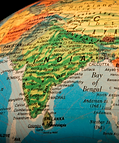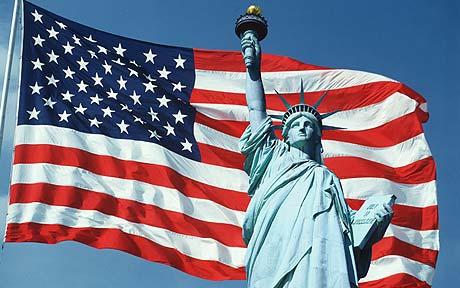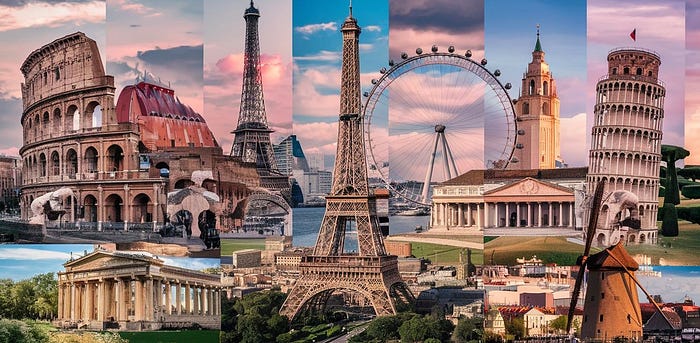Look at the map of India. History and Geography haven’t been kind to India.
On its North-East border, it shares a ~3,400 km (2,111 mile) border with China. 1
On its North-West border, India shares an almost similar ~3,200 km border with Pakistan. 2
Map 1: India’s Permanent Headache!
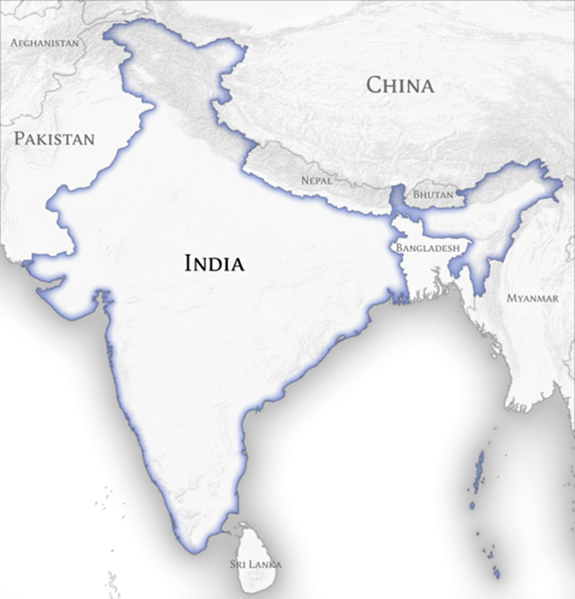
Source: Wikipedia
The McMahon Line (named after British civil servant Sir Henry McMahon) defines some part of the India-Tibet-China border. 3
The Radcliffe line (named after British lawyer Sir Cyril Radcliffe, who was given six weeks to partition the Hindu and Sikh populated regions to India and Muslim majority regions along the Rajasthan-Punjab border in the west of India to Pakistan on the east of India near Bengal to East Pakistan. 4
Of course, there is also a Durand Line which partitions Afghanistan and Pakistan. 5
It is pertinent to note that arbitrary lines drawn across countries by colonisers like the British empire, be it in South Asia or the Middle East, remain the biggest source of conflict even in today’s times.
China disputes the McMahon line and the border length. It claims a large part of Ladakh and the entire state of Arunachal Pradesh as its territory.
Unable to resolve the border tensions, China and India fought a war in 1962, with its outcome resulting in a Line of Actual Control (LAC) 6. The LAC is not settled and we have had many squabbles over it with the most recent one in 2020/2021 7.
Pakistan has always claimed parts of Kashmir as their territory and we have fought four official wars over it (1948, 1965, 1971 and 1999). The ’71 war led to the liberation of East Pakistan into an independent country, Bangladesh. In 1972, India agreed to a Line of Control to ease the tensions on the north-western border. 8
Map 2: Kashmir, as India officially views it:
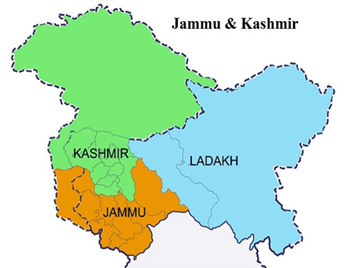
Source: Article on Josh Jagron website, Aug 2019
Map 3: Kashmir, as Pakistan and China view it:
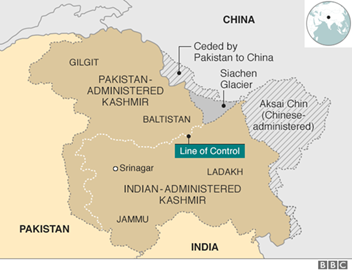
Source: BBC- refer Map 1 for complete India map
India’s head has been more like a Permanent Headache . Like a consistent migraine.
People who suffer migraines, adapt and learn to carry on with their regular life. India has managed to deal with its problems on the border and carry on as well.
However, over the last three decades, India has faced several acts of what it believes is cross border terrorism from Pakistani soil. This has on occasions moved from the border areas surrounding Kashmir, deep into India cities with mass civilian and non-civilian casualties. (See Annexure on timeline of flashpoints and flare-ups in India-Pakistan ties).
In December 1989, after decades of a dispute which was confined to border areas, Kashmir sunk into a full-fledged separatist movement. It is noteworthy that Russia withdrew from Afghanistan in 1989. The arms used to trouble the Russians were still sloshing around in Pakistan and could now be solely focused on Kashmir. The Taliban, a creation of the Pakistan intelligence agency, ISI, was now free to cause trouble in Kashmir and stunt India.
India sees these acts as part of the Pakistan state doctrine of ‘bleeding India by thousand cuts. 9 The genesis of the conflict may have been related to the issue of Kashmir. However, we believe, the motive is to foment religious divides, sow fear, and stymie India’s progress. This isn’t only about Kashmir.
India lowers its Pain Threshold
Just as a patient with migraine tries to manage the symptoms though prevention and responds to a usual aggravation with regular medicines. India has also tried managing the situation through covert operations, diplomacy, and using economic, financial, trade and cultural sanctions against Pakistan.
However, if something triggers a persistent migraine, the person resorts to a stronger dosage.
Similarly, India has reduced its pain and tolerance threshold and started responding to certain terrorist activities with an overt military operation.
Table 1: Timeline of recent skirmishes between India and Pakistan
Date | Event | India's Response | Pakistan's Response |
|---|---|---|---|
18th September 2016 | Uri (Jammu & Kashmir) – 4 Terrorist attack an Indian army brigade headquarters killing 19 soldiers | 29th September 2016 | Claims no such event took place. |
14th February 2019 | Pulwama (Jammu & Kashmir): Indian military convoy attacked by suicide bomber killing 40 soldiers | 26th February 2019 | 27th February 2019 |
22nd April 2025 | Pahalgam (Jammu & Kashmir): Four terrorists gun down 26 civilians (all males) in a tourist spot in Pahalgam, Kashmir. The tourists were religiously profiled before being killed with 24 of them Hindu, 1 Christian and 1 Muslim | 23rd April 2025 May 7th Morning May 7/8 May 9/10 May 10 | Pakistan suspends the 1971 Simla Agreement which recognises the Line of Control as tentative boundary. May 7/8 May 9 May 10 No further escalation |
Source: Indian Express, The Times of India and other media sources
Graph 1: Uri Aftermath (90 Days): BSE-30 Sensex Index Slipped 7.4%, Rupee Depreciated 1.2%, Yields Declined by 36 bps to 6.51%.
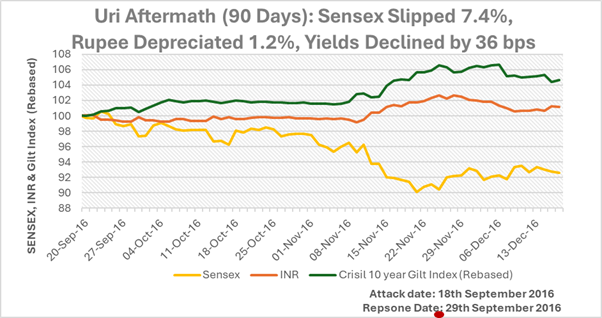
Source: Bloomberg Finance L.P
Past performance is not an indicator of future result.
Graph 2: Pulwama Aftermath (90 Days): BSE-30 Sensex Index rose 3.6%, Rupee Appreciated 0.5%, Yields Rose by 9 bps to 7.38%.
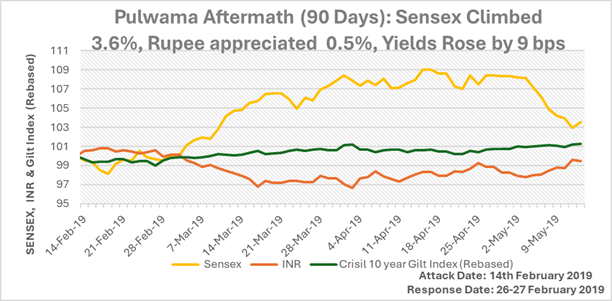
Source: Bloomberg Finance L.P
Past performance is not an indicator of future result.
Graph 3
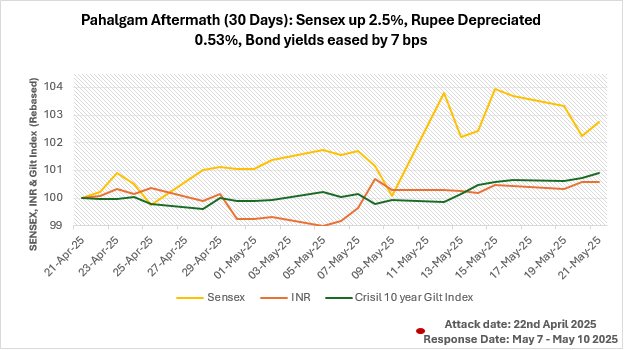
Source: Bloomberg Finance L.P; May 7-10 saw retaliatory strikes. Past performance is not an indicator of future result.
These incidents have been short lived and hasn’t caused any major impact on the economy and on the markets.
However, India needs to be careful. History, Geography and Global Diplomacy are not always in its favour.
The Pakistan-China-US history and nexus
In the 1971 war, the US (led by President Nixon and National Security Advisor Henry Kissinger) backed Pakistan and supported the China view that India needed to be contained. Russia supported India. The US continued to need Pakistan due to its critical geographical location: (i) to fight the Russians in Afghanistan from 1979 till 1989 (think Bin Laden as a loyal soldier of the Pakistan-controlled Taliban perched on the mountain ranges of Pakistan waiting to attack Russian soldiers in Afghanistan) and, (ii) to ensure that the US had a firm base close to the Middle East to oversee Iran, which had gone rogue with the induction of Ayatollah Khomeini as the Supreme Leader. Pakistan buys US F-16s and other military arsenal. As late as June 2016, the US Senate set up a fund to give Pakistan USD 800 million for its help in the “war against terror”! 10 Yes, this to a country that had Bin Laden hanging around for a few years in a secure compound till the Seals got to him.
However, given India’s growing economy and its potential as a competitor to China, the US has improved relations with India since the Bill Clinton administration. India signed a nuclear deal with the US in 2008. India now shares security relationship with US, Japan, Australia as a member of the ‘QUAD.’ US investors are the largest deployer of capital into Indian equities, bonds, and private/real assets.
On the other hand, China has even deeper interests in Pakistan. China has already taken over certain areas of Pakistan administered Kashmir (see Map 3). More than 60% of Pakistan’s new military equipment – fighter jets, drones, radar systems are Chinese11. China has poured billions in developing the China-Pakistan Economic corridor.
Graph 4: A passage for China to the Arabian Sea and Indian Ocean
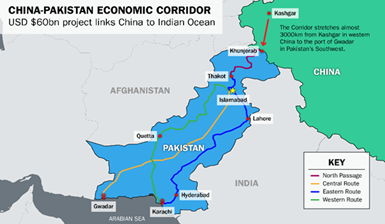
(Source: CPEC)
India needs to be careful.
China needs Pakistan for a cheap proxy to scuttle India's economic and global ambitions. Many geo-political experts claim this recent conflagration to be triggered by China to tie India down at a time when the global reset is favourable for India. Some have also conjectured that it was a live test case for Chinese weapons, jets, missiles, drones, and radar systems which are used by Pakistan.
China may not have liked what they saw given India’s dominance and command in this skirmish and its unchallenged ability to hit key military targets deep inside Pakistan. However, the fact that India agreed to ceasefire despite having the upper hand is a testament to India’s stand that left to its own, India has no interest in dealing with Pakistan.
Has Trump ‘re-hyphenated’ India and Pakistan?
India began to de-hyphenate from Pakistan by a) insisting on no third-party mediation to resolve its issues with Pakistan on Kashmir; b) de-coupling and growing at a much faster pace in a democratic set up where India gains economic significance in global relations and c) delineating the issue of Kashmir’s sovereignty and the response to acts of terror fomented by Pakistan.
However, Trump’s assertions that US mediated a ceasefire between India and Pakistan and his contorted understanding of the situation by claiming to find a solution to a biblical like thousand-year-old conflict in Kashmir 12, haven’t gone down well with India.
Although the world acknowledged India’s right to respond to the terror attack, however, in their minds the issue isn’t only about terror, but an issue of India-Kashmir-Pakistan.
India seems to have failed to state its narrative that responding to terrorist attacks on civilians has nothing to do with the issue of sovereignty of Kashmir.
We believe India would do well to turn the world’s attention back to its economy, investments and its long-term potential.
Graph 5: The upward slope of this line should be India and Pakistan’s key focus
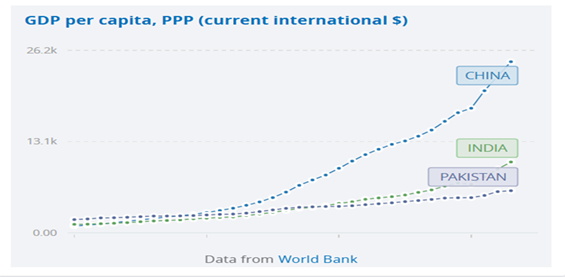
(PPP- Purchasing Power Parity; Annual Data from 1990 till 2023);
Y-axis = per capital income in US$ - PPP; X-axis – time period – 1990-2023
Please note that the historical results are not indicative of future results.
We believe that India with a GDP growing at ~6.5% per annum and aspirations of being a ‘superpower’ to join the ranks of the USA and China does not want to be bogged down in a military conflict. We believe Pakistan with a failing economy does not have the resources for a prolonged military conflict. The local political landscape and the inherent divide between India and Pakistan, since the British withdrew in 1947, tends to ramp up activity beyond what each country can economically afford.
India - as with any country - will be hurt by a prolonged border issue. But investors must note that we believe this is a problem that will never go away. The geography of the world has been very unkind to India. We must deal with troublesome Pakistan on the west and a frighteningly resurgent China on the east/north.
If you need a detailed history and context, please also read:
https://qasl.com/post/india-geopolitics-pakistan-china
https://qasl.com/post/how-geo-politics-shaped-india-75
Superscript Sources and Footnotes:
- 1-8: respective Wikipedia pages of data and events mentioned.
- 9: Article in Wion News on the genesis of “bleeding India by a thousand cuts”, May 6, 2025
- 10: Article in Dawn News, June 16, 2016
- 11: Article in Defence Security Asia, Mar 17, 2025
- 12: Article in Times of India, May 12, 2025, quoting Congress party spokesperson Manish Tewari
Appendix
Table: TimeLine: flashpoints and flare-ups in India-Pakistan Ties;
Here is a look at highs and mostly lows in relations between India and Pakistan
1947/48 | India and Pakistan go to war over Kashmir; war ends with UN-ordered ceasefire and resolution seeking a plebiscite for people in Jammu & Kashmir to decide whether to become a part of India or Pakistan |
|---|---|
April-1965 | Second war over Kashmir. Fighting ends after UN calls for ceasefire |
December-1971 | Third Indo-Pak war, this time over East Pakistan, which becomes Bangladesh (see the Archer Blood Telegram) |
July-1972 | Zulfikar Ali Bhutto and Indira Gandhi sign Simla pack over principles meant to govern relations |
December-1989 | Separatist revolt starts in J&K. India accuses Pak of arming and sending militants, which Pak denies; end of Russian rule in Afghanistan; Taliban, created by Pakistan’s ISI intelligence unit, now idle and ready for other mischief. US supplied arms available in Pakistan’s open bazaars for a few dollars |
May-1998 | India conducts nuclear tests. Pak responds with its own tests |
January-1999 | Indian PM Atal Bihari Vajpayee holds summit with Pakistani counterpart Nawaz Sharif in Lahore |
May-1999 | India and Pakistan wage war in mountains above Kargil on the Line of Control |
July-2001 | Summit between General Pervez Musharraf and Indian PM Vajpayee in Agra ends in failure |
December-2001 | Militants attack Indian Parliament. India blames Pak-based terrorist groups group Lashkar-e-Taiba (LeT) and Jaish-e-Mohammad. One million troops are mobilised on either side |
November-2003 | Pakistan, India agrees on ceasefire |
November-2008 | Terrorists launch three days of multiple attacks in Mumbai, killing 166 people; India blames Pakistan and US citizen David Headley, a member of the terrorist organization LeT and – simultaneously – an informant for the US based Drug Enforcement Agency |
February-2009 | India cautiously welcomes Pak’s probe into Mumbai attack. Pak admits the attack was launched and partly planned from its soil |
June-2009 | PM Manmohan Singh and Pak President Zardari meet on sidelines of an international gathering in Russia |
April-2012 | Zardari meets Singh in New Delhi in the highest-level meeting on each other’s soil in 7 years |
November-2012 | India hangs Kasab, the lone survivor of Mumbai attacks of November 2008 |
January-2013 | India accuses Pak of “barbaric and inhuman” behaviour after two Indian soldiers are beheaded. Peace talks stall and PM Singh says there can be no “business as usual” |
February-2013 | India hangs Afzal for the attack on India’s Parliament in 2001 |
May-2014 | PM Sharif of Pakistan attends swearing-in of India’s the new Union Council of Ministers, meets PM Modi |
July-2015 | Modi and Sharif met on the sidelines of the Shanghai Cooperation Organisation |
December-2015 | Modi makes a surprise stopover in Lahore, Pakistan on way back from Kabul and meets PM Sharif |
January-2016 | Six terrorists strike at Pathankot, India airbase |
August-2016 | PM of India mentions Baloch struggle in his I-Day speech |
September-2016 | Pakistan–based terrorists kill 18 soldiers in Uri |
September-2016 | India asserts mutual trust, and cooperation is necessary for Indus River Waters Treaty to work |
February-2019 | 4 terrorists strike at Pulwama, India |
February-2019 | India launches air strikes on Balakot, Pakistan |
August-2019 | India abolishes Article 370 in the Indian constitution which granted Kashmir a special status |
April-2025 | 4 terrorists strike at Pahalgam killing 26 civilians |
April-2025 | India suspends World Bank brokered Indus River Water Treaty which allowed Pakistan to claim a share of river water flowing through Indian-administered Kashmir |
May-2025 | India strikes at nine locations in Pakistan known to be terrorist training centres |
Source: MEA.Gov.in, Media Reports and Reuters, The Economic Times/Mumbai/Friday/ 30 September 2016/Media reports
Table: India outweighs Pakistan in conventional weapons, but a nuke is a nuke.
| India | Pakistan | |
|---|---|---|
| Military spend, 2024 | $86 bn | $10 bn |
| Land border | 9,445 miles | 4209 miles |
| Coastal border | 3,800 miles | 650 miles |
| Personnel strength | 5.1 Mn | 1.7 Mn |
| Aircraft | 2229 | 1399 |
| Combat Tanks | 3151 | 1839 |
| Naval assets | 293 | 121 |
| Missiles with nuclear warheads | 180 | 170 |
Source: Al Jazeera article of May 8, 2025 citing data from global firepower
Important Disclosures & Disclaimers
The views expressed herein shall constitute only the opinions and any information contained in this material shall not be deemed to constitute an advice or an offer to sell/purchase or as an invitation or solicitation to invest in any security and further Quantum Advisors Private Limited (QAPL) and its employees/directors shall not be liable for any direct or indirect loss, damage, liability whatsoever arising from the use of this information.
Information sourced from third parties cannot be guaranteed or was not independently verified. Whilst no action has been solicited based upon the information provided herein, due care has been taken to ensure that the facts are accurate, and the views given are fair and reasonable as on date. All the forward-looking statements made in this communication are inherently uncertain and we cannot assure the reader that the results or developments anticipated will be realized or even if realized, will have the expected consequences to or effects on, us or our business prospects, financial condition or results of operations.
Recipients should exercise due care and caution and if necessary, obtain the professional advice prior to taking any decision based on this information.
Important Notice:
This newsletter contains hyperlinks to websites operated by third parties. These linked websites are not under the control of QAPL and are provided for your convenience only. Clicking on those links or enabling those connections may allow third parties to collect or share data about you. When you click on these links, we encourage you to read the privacy notice of the website you visit. QAPL does not endorse, or guarantee products, services or advice offered by these websites.
UK related important disclosures:
• The content of this newsletter has not been approved by an authorised person within the meaning of the Financial Services and Markets Act 2000 (“FSMA 2000”). Reliance on this newsletter for the purpose of engaging in any investment activity may expose you to a significant risk of losing all of the property or other assets you invest or of incurring additional liability. This newsletter is exempt from section 21 FSMA 2000 on the grounds that it is directed only to certified sophisticated investors, high net worth companies, unincorporated associations, trusts and/or investment professionals within the meaning of the Financial Services and Markets Act 2000 (Financial Promotion) Order 2005 (“FPO”). The investment activity described in this newsletter is only available to these persons or entities and no other person or entity should rely on the contents of this document.
• The protections conferred by or under the Financial Services and Markets Act (FSMA) will not apply to this newsletter and any investment activity that may be engaged in as a result of this newsletter.
The applicability of any dispute resolution scheme or compensation scheme and its jurisdiction (if and where applicable) pertaining to a transaction resulting from this newsletter would be as specified in the respective client agreements.

